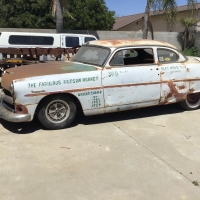Permatex question

in HUDSON
I'm replacing the head gasket on my Super Wasp and purchasing some items to complete the job such as Copper Coat to spray on the head gasket itself. I was also a bit confused at the auto parts store the other day as to what would be the best product to coat the ends of the head bolts to prevent any leaking anti-freeze after torqueing them down. There were numerous Permatex gasket products, but I'm wondering which would be best for this job. Any recommendations? Thanks! Dan
0
Comments
-
I use liquid teflon on the head bolts.0
-
Yes, forgot to mention... but handy for other screws entering the water jacket like on the water pump... and if you adapt coolant to run through the intake heat passage and need to seal the carb studs...0
-
Thanks everybody for your suggestions on a thread sealant. I'm thinking of going with the Permatex product Ken U-tex has suggested. Got the head off today and spent the afternoon cleaning out the head bolt holes with a tap. Next concern is what's the best method for cleaning the carbon and other left over gasket material from the head and block surfaces. I'm thinking of using something like Brakleen or WD-40 on a rag along with a small metal scraper.0
-
The head is fairly easy. A rotary wire brush chucked into a drill motor will do the job rather well. If it were me, I'd run the head to a local machine shop and have them hot tank it and surface it at a minimum. Long thin heads as these tend to warp, with the center low (with the sealing surface up), not unlike a hot dog on a grill. One pass and a hot tank should run about $50-$75, and it's money well spent. The majority of engine heat is rejected to the cylinder head, so it's important the cooling passages are clear. Hot tanking will get most, if not all, of the crud out of the head's coolant passages.railknight said:Thanks everybody for your suggestions on a thread sealant. I'm thinking of going with the Permatex product Ken U-tex has suggested. Got the head off today and spent the afternoon cleaning out the head bolt holes with a tap. Next concern is what's the best method for cleaning the carbon and other left over gasket material from the head and block surfaces. I'm thinking of using something like Brakleen or WD-40 on a rag along with a small metal scraper.
As for the block, I'd hand wire brush around the valves with a small brass brush. To keep junk from going down the bolt holes, put the first two rows of bolts into the threads you just cleaned. Stuff rags in every cylinder hole to keep debris from the bores. I use a heavy duty box knife blade and take my time on the sealing surfaces, and do cleanup with acetone on a rag, although there are gasket removal chemicals available.
Pull the rags from the bores, and use some sort of flexible plastic scraper to dig out whatever debris might be lurking between the piston and the cylinder down to the first compression ring. I've seen scored cylinder walls from leftover crud - and you don't want that! Blow it all out THOROUGHLY with compressed air, and you're ready for re-assembly.
As an aside - I don't know the exact numbers for milling the head, but since you're down this far, removing material from the head will increase the compression ratio and give you some more "grunt". I believe stock compression is 6.7:1, with optional compression at 7.2:1. Someone here should be able to provide a safe milling dimension for the head. It's cheap horsepower!
0 -
Head was surfaced at a machine shop when the entire engine was rebuilt two years ago by Doug Wildrick. Engine has about 2500 miles on it since then. I plan to use a shop vacuum to clean up around the bolt holes, valves and pistons as I go along carefully scraping the old gasket material and carbon buildup. Just a thin layer of carbon on the piston tops which may be rubbed off with a rag sprayed with a can of carb. cleaner (has acetone in it). But just in case, yes, a plastic scraper is a must when working on the piston tops to avoid scoring the cylinder walls. I like the idea of hitting the work area with blasts of air which I'll do to the block and coolant passageways and bolt holes in the head. Just taking my time here as I've only replaced a head gasket once before about 15 years ago on a 1950 Pacemaker with a 232. Also, ordered a new set of 7/16 head bolts from Dale Cooper. Thanks again for advice here!
0
Categories
- 36.9K All Categories
- 112 Hudson 1916 - 1929
- 20 Upcoming Events
- 92 Essex Super 6
- 28.6K HUDSON
- 571 "How To" - Skills, mechanical and other wise
- 995 Street Rods
- 151 American Motors
- 178 The Flathead Forum
- 49 Manuals, etc,.
- 78 Hudson 8
- 44 FORUM - Instructions and Tips on using the forum
- 2.8K CLASSIFIEDS
- 608 Vehicles
- 2.1K Parts & Pieces
- 77 Literature & Memorabilia
- Hudson 1916 - 1929 Yahoo Groups Archived Photos

